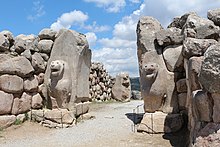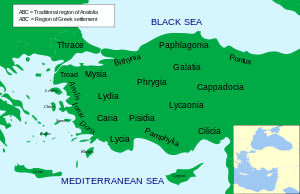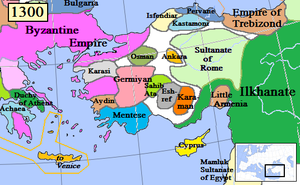Anatolia
From Wikipedia, the free encyclopedia
For other uses, see Anatolia (disambiguation) and Asia Minor (disambiguation).
Coordinates: 39°N 35°E
The location of Turkey (within the rectangle) in reference to the European continent. Most of Asian Turkey is located on the Anatolian peninsula, the eastern boundary of which is a diagonal line between the Gulf of Alexandretta on the Mediterranean coast and Artvin Province on the Black Sea coast. Eastern Anatolia and Southeastern Anatolia were historically part of the Armenian Highlands and Upper Mesopotamia. However, the First Geography Congress of Turkey in 1941 defined Anatolia roughly as a rectangle, with the Black Sea coast of Turkey forming the rectangle's length, therefore also including the hinterland to the east of the Gulf of Alexandretta–Artvin Province line within Turkey.[1] Since then, Anatolia is often considered to be synonymous with Asian Turkey.[2][3]
According to the traditional definition, the eastern boundary of the Anatolian peninsula is a diagonal line that extends from the Gulf of Alexandretta on the Mediterranean coast of Turkey to the shores of Artvin Province on the eastern Black Sea coast of the country. The mountainous plateau to the east of this line was historically known as the Armenian Highlands (Armenia Major). This region is now named (and largely situated within) the Eastern Anatolia Region in the far east of Turkey and converges with the Lesser Caucasus — an area that was incorporated in the Russian Empire region of Transcaucasia in the 19th century.[4][5] Thus, traditionally, Anatolia is the territory that comprises approximately the western two-thirds of the Asian part of Turkey. Since the early 20th century, Anatolia is often considered to be synonymous with Asian Turkey, which comprises more than 95% of the country's total land area,[6] and its eastern and southeastern borders are widely perceived as Turkey's borders with neighboring Georgia, Armenia, Azerbaijan, Iran, Iraq, and Syria, in clockwise direction.
The ancient inhabitants of Anatolia spoke the now-extinct Anatolian languages, which were largely replaced by the Greek language starting from classical antiquity and during the Hellenistic, Roman and Byzantine periods. The Turkification of Anatolia began under the Seljuk Empire in the late 11th century and continued under the Ottoman Empire between the early 14th and early 20th centuries. However, various non-Turkic languages continue to be spoken by minorities in Anatolia today, including Kurdish, Assyrian, Armenian, Arabic, Laz, Georgian, and Greek.
Contents
- 1 Definition
- 2 Etymology
- 3 History
- 4 Geography
- 5 Demographics
- 6 Cuisine
- 7 See also
- 8 References
- 9 Bibliography
- 10 External links
Definition
Further information: Geographical name changes in Turkey
The traditional definition of the Anatolian peninsula within modern Turkey,[7][8] with the diagonal line between the Gulf of Alexandretta and Artvin Province forming the peninsula's eastern border. The First Geography Congress in 1941 defines Anatolia roughly as a rectangle, with the Black Sea coast of Turkey forming the rectangle's length, therefore including the hinterland to the east of the Gulf of Alexandretta–Artvin Province line within Turkey.[1]
1907 map of Asia Minor, showing the local ancient kingdoms. The map includes the East Aegean Islands and the island of Cyprus to Anatolia's continental shelf.
Traditionally, Anatolia is considered to extend in the east to an indefinite diagonal line running from the Gulf of Alexandretta on the Mediterranean coast to Artvin Province on the Black Sea coast, coterminous with the Anatolian Plateau. This traditional geographical definition is used, for example, in the latest edition of Merriam-Webster's Geographical Dictionary,[7] as well as the archeological community.[8] Under this definition, Anatolia is bounded to the east by the Armenian Highlands, and the Euphrates before that river bends to the southeast to enter Mesopotamia.[8] To the southeast, it is bounded by the ranges that separate it from the Orontes valley in Syria (region) and the Mesopotamian plain.[8]
Following the Armenian Genocide in the Ottoman Empire during World War I and the establishment of the Turkish Republic in the aftermath of the Turkish War of Independence, the western part of the Armenian Highlands were renamed Eastern Anatolia by the Turkish government in 1941,[9][10] and the name Anatolia has effectively become co-terminous with Asian Turkey. Turkey's First Geography Congress in 1941 created two regions to the east of the Gulf of Alexandretta–Artvin Province line, named the Eastern Anatolia Region and the Southeastern Anatolia Region;[11] the former largely corresponding to the western part of the Armenian Highlands, and the latter to the northern part of Upper Mesopotamia. The definition made by the First Geography Congress in 1941 describes Anatolia roughly as a rectangle, with the Black Sea coast of Turkey forming the rectangle's length, therefore also including the hinterland to the east of the Gulf of Alexandretta–Artvin Province line within Turkey.[1] Since then, Anatolia is often considered to be synonymous with Asian Turkey.[6] This wider definition of Anatolia has gained widespread currency outside of Turkey and has, for instance, been adopted by Encyclopædia Britannica[2] and other encyclopedic and general reference publications.[3] Davidian terms the expanded use of "Anatolia" to apply to territory formerly referred to as Armenia as "an historical imposition", and notes that a growing body of literature is uncomfortable with referring to the Ottoman East as "Eastern Anatolia".[12]
Etymology
The oldest known reference to Anatolia – as “Land of the Hatti” – was found on Mesopotamian cuneiform tablets from the period of the Akkadian Empire (2350–2150 BC).[citation needed] The first name the Greeks used for the Anatolian peninsula was Ἀσία (Asía),[13] presumably after the name of the Assuwa league in western Anatolia.[citation needed] As the name of Asia came to be extended to other areas east of the Mediterranean, the name for Anatolia was specified as Μικρὰ Ἀσία (Mikrá Asía) or Asia Minor, meaning “Lesser Asia”, in Late Antiquity.The name Anatolia derives from the Greek ἀνατολή (anatolḗ) meaning “the East” or more literally “sunrise”, comparable to the Latin derived terms “levant” and “orient”.[14][15] The precise reference of this term has varied over time, perhaps originally referring to the Aeolian, Ionian and Dorian colonies on the west coast of Asia Minor. In the Byzantine Empire, the Anatolic Theme (Aνατολικόν θέμα) was a theme covering the western and central parts of Turkey’s present-day Central Anatolia Region.[16][17] The modern Turkish form of Anatolia is Anadolu, which again derives from the Greek name Aνατολή (Anatolḗ). The Russian male name Anatoly and the French Anatole share the same linguistic origin.
In English the name of Turkey for ancient Anatolia first appeared c. 1369. It is derived from the Medieval Latin Turchia (meaning “Land of the Turks”, Turkish Türkiye), which was originally used by the Europeans to define the Seljuk controlled parts of Anatolia after the Battle of Manzikert.[citation needed]
History
Main article: History of Anatolia
Prehistory
Mural of aurochs, a deer, and humans in Çatalhöyük, which is the largest and best-preserved Neolithic site found to date. It was registered as a UNESCO World Heritage Site in 2012.[18]
Ancient Near East (Bronze and Iron Ages)
Hattians and Hurrians
The earliest historical records of Anatolia stem from the southeast of the region and are from the Mesopotamian-based Akkadian Empire during the reign of Sargon of Akkad in the 24th century BC. Scholars generally believe the earliest indigenous populations of Anatolia were the Hattians and Hurrians. The Hattians spoke a language of unclear affiliation, and the Hurrian language belongs to a small family called Hurro-Urartian, all these languages now being extinct; relationships with indigenous languages of the Caucasus have been proposed[20] but are not generally accepted. The region was famous for exporting raw materials, and areas of Hattian- and Hurrian-populated southeast Anatolia were colonised by the Akkadians.[21]Assyrian Empire (21st–18th centuries BC)
After the fall of the Akkadian Empire in the mid-21st century BC, the Assyrians, who were the northern branch of the Akkadian people, colonised parts of the region between the 21st and mid-18th centuries BC and claimed its resources, notably silver. One of the numerous cuneiform records dated circa 20th century BC, found in Anatolia at the Assyrian colony of Kanesh, uses an advanced system of trading computations and credit lines.[21]Hittite Kingdoms (17th–12th centuries BC)
The Lion Gate at Hattusa, capital of the Hittite Empire. The city's history dates to before 2000 BC.
The Hittites adopted the cuneiform script, invented in Mesopotamia. During the Late Bronze Age circa 2000 BC, they created an empire, the Hittite New Kingdom, which reached its height in the 14th century BC, controlling much of Asia Minor. The empire included a large part of Anatolia, northwestern Syria and northwest upper Mesopotamia. They failed to reach the Anatolian coasts of the Black Sea, however, as another non-Indo-European people, the Kaskians, had established a kingdom there in the 17th century BC, displacing earlier Palaic-speaking Indo-Europeans.[22] Much of the history of the Hittite Empire concerned war with the rival empires of Egypt, Assyria and the Mitanni.[23]
The Egyptians eventually[dubious ] withdrew from the region after failing to gain the upper hand over the Hittites and becoming wary of the power of Assyria, which had destroyed the Mitanni Empire.[23] The Assyrians and Hittites were then left to battle over control of eastern and southern Anatolia and colonial territories in Syria. The Assyrians had better success than the Egyptians, annexing much Hittite (and Hurrian) territory in these regions.[24]
Neo-Hittite kingdoms (c. 1180–700 BC)
After 1180 BC, during the Late Bronze Age collapse, the Hittite empire disintegrated into several independent Syro-Hittite states, subsequent to losing much territory to the Middle Assyrian Empire and being finally overrun by the Phrygians, another Indo-European people who are believed to have migrated from the Balkans. The Phrygian expansion into southeast Anatolia was eventually halted by the Assyrians, who controlled that region.[24]- Arameans
- Luwians
Lycian rock cut tombs of Kaunos (Dalyan)
Neo-Assyrian Empire (10th–7th centuries BC)
From the 10th to late 7th centuries BC, much of Anatolia (particularly the east, central, southwestern and southeastern regions) fell to the Neo-Assyrian Empire, including all of the Syro-Hittite states, Phrygia, Tabal, Cilicia, Kingdom of Commagene, Caria, Lydia, the Cimmerians and Scythians and swathes of Cappadocia.The Neo-Assyrian empire collapsed due to a bitter series of civil wars followed by a combined attack by Medes, Persians, Scythians and their own Babylonian relations. The last Assyrian city to fall was Harran in southeast Anatolia. This city was the birthplace of the last king of Babylon, the Assyrian Nabonidus and his son and regent Belshazzar. Much of the region then fell to the short-lived Iran-based Median Empire, with the Babylonians and Scythians briefly appropriating some territory.
Cimmerian and Scythian invasions (8th–7th centuries BC)
From the late 8th century BC, a new wave of Indo-European-speaking raiders entered northern and northeast Anatolia: the Cimmerians and Scythians. The Cimmerians overran Phrygia and the Scythians threatened to do the same to Urartu and Lydia, before both were finally checked by the Assyrians.Greek West
The north-western coast of Anatolia was inhabited by Greeks of the Achaean/Mycenaean culture from the 20th century BC, related to the Greeks of south eastern Europe and the Aegean.[27] Beginning with the Bronze Age collapse at the end of the 2nd millennium BC, the west coast of Anatolia was settled by Ionian Greeks, usurping the area of the related but earlier Mycenaean Greeks. Over several centuries, numerous Ancient Greek city-states were established on the coasts of Anatolia. Greeks started Western philosophy on the western coast of Anatolia (Pre-Socratic philosophy).[27]Classical antiquity
Ancient regions of Anatolia (500 BC)
The Dying Galatian was a famous statue commissioned some time between 230–220 BC by King Attalos I of Pergamon to honor his victory over the Celtic Galatians in Anatolia.
During the 6th century BC, all of Anatolia was conquered by the Persian Achaemenid Empire, the Persians having usurped the Medes as the dominant dynasty in Iran. In 499 BC, the Ionian city-states on the west coast of Anatolia rebelled against Persian rule. The Ionian Revolt, as it became known, though quelled, initiated the Greco-Persian Wars, which ended in a Greek victory in 449 BC, and the Ionian cities regained their independence, alongside the withdrawal of the Persian forces from their European territories.
In 334 BC, the Macedonian Greek king Alexander the Great conquered the peninsula from the Achaemenid Persian Empire.[30] Alexander's conquest opened up the interior of Asia Minor to Greek settlement and influence.
Sanctuary of Commagene Kings on Mount Nemrut (1st century BC)
Early Christian period
After the division of the Roman Empire, Anatolia became part of the East Roman, or Byzantine Empire. Anatolia was one of the first places where Christianity spread, so that by the 4th century AD, western and central Anatolia were overwhelmingly Christian and Greek-speaking. For the next 600 years, while Imperial possessions in Europe were subjected to barbarian invasions, Anatolia would be the center of the Hellenic world. Byzantine control was challenged by Arab raids starting in the eighth century (see Arab–Byzantine wars), but in the ninth and tenth century a resurgent Byzantine Empire regained its lost territories, including even long lost territory such as Armenia and Syria (ancient Aram).Islamic rule replacing Byzantium
Byzantine Anatolia and the Byzantine-Arab frontier zone in the mid-9th century
Beyliks and other states around Anatolia, c. 1300.
In 1255, the Mongols swept through eastern and central Anatolia, and would remain until 1335. The Ilkhanate garrison was stationed near Ankara.[32][33] After the decline of the Ilkhanate from 1335–1353, the Mongol Empire's legacy in the region was the Uyghur Eretna Dynasty that was overthrown by Kadi Burhan al-Din in 1381.[34]
By the end of the 14th century, most of Anatolia was controlled by various Anatolian beyliks. Smyrna fell in 1330, and the last Byzantine stronghold in Anatolia, Philadelphia, fell in 1390. The Turkmen Beyliks were under the control of the Mongols, at least nominally, through declining Seljuk sultans.[35][36] The Beyliks did not mint coins in the names of their own leaders while they remained under the suzerainty of the Mongol Ilkhanids.[37] The Osmanli ruler Osman I was the first Turkish ruler who minted coins in his own name in 1320s, for it bears the legend "Minted by Osman son of Ertugul".[38] Since the minting of coins was a prerogative accorded in Islamic practice only to a sovereign, it can be considered that the Osmanli, or Ottoman Turks, became formally independent from the Mongol Khans.[39]
Ottoman Empire
Among the Turkmen leaders the Ottomans emerged as great power under Osman and his son Orhan I.[citation needed] The Anatolian beyliks were successively absorbed into the rising Ottoman Empire during the 15th century.[citation needed] It is not well understood how the Osmanli, or Ottoman Turks, came to dominate their neighbours, as the history of medieval Anatolia is still little known.[40] The Ottomans completed the conquest of the peninsula in 1517 with the taking of Halicarnassus (modern Bodrum) from the Knights of Saint John.[citation needed]Modern times
Ethnographic map of Anatolia from 1911.
A continuous reverse migration occurred since the early 19th century, when Greeks from Anatolia, Constantinople and Pontus area migrated toward the newly independent Kingdom of Greece, and also towards the United States, southern part of the Russian Empire, Latin America and rest of Europe.
Following the Russo-Persian Treaty of Turkmenchay (1828) and the incorporation of the Eastern Armenia into the Russian Empire, another migration involved the large Armenian population of Anatolia, which recorded significant migration rates from Western Armenia (Eastern Anatolia) toward the Russian Empire, especially toward its newly established Armenian provinces.
Anatolia remained multi-ethnic until the early 20th century (see the rise of nationalism under the Ottoman Empire). During World War I, the Armenian Genocide, the Greek genocide (especially in Pontus), and the Assyrian genocide almost entirely removed the ancient indigenous communities of Armenian, Greek, and Assyrian populations in Anatolia and surrounding regions. Following the Greco-Turkish War of 1919–1922, most remaining ethnic Anatolian Greeks were forced out during the 1923 population exchange between Greece and Turkey. Many more have left Turkey since, leaving less than 5,000 Greeks in Anatolia today. Since the foundation of the Republic of Turkey in 1923, Anatolia has been within Turkey, its inhabitants being mainly Turks and Kurds (see demographics of Turkey and history of Turkey).
Geography
Main article: Geography of Turkey
Geology
Main article: Geology of Turkey
Anatolia's terrain is structurally complex. A central massif composed of uplifted blocks and downfolded troughs, covered by recent deposits
and giving the appearance of a plateau with rough terrain, is wedged
between two folded mountain ranges that converge in the east. True
lowland is confined to a few narrow coastal strips along the Aegean,
Mediterranean, and Black Sea coasts. Flat or gently sloping land is rare
and largely confined to the deltas of the Kızıl River, the coastal plains of Çukurova and the valley floors of the Gediz River and the Büyük Menderes River as well as some interior high plains in Anatolia, mainly around Lake Tuz (Salt Lake) and the Konya Basin (Konya Ovasi).Climate
Main article: Climate of Turkey














No comments:
Post a Comment